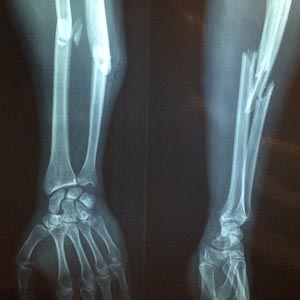The etiology and pattern distribution of closed long bone diaphyseal fractures: A prospective survey in a regional trauma center Enugu, Nigeria

Accepted: 11 February 2022
All claims expressed in this article are solely those of the authors and do not necessarily represent those of their affiliated organizations, or those of the publisher, the editors and the reviewers. Any product that may be evaluated in this article or claim that may be made by its manufacturer is not guaranteed or endorsed by the publisher.
Authors
Extremity injuries have attained a significant position in musculoskeletal trauma. This study aims to describe the pattern of closed long bone diaphyseal fractures in acute trauma setting. A prospective study of patients who presented at the trauma unit of National Orthopaedic Hospital Enugu over a 6months period was undertaken. Sixty two patients with closed long bone diaphyseal fractures of femur, tibia and humerus who consented and met the study inclusion criteria were prospectively included and evaluated. Data was analyzed using the Statistical Package for the Social Sciences version 20. A total of 2880 patients presented during the period of study out of which, 62 (37 males and 25 females) presented with closed long bone diaphyseal fractures giving an incidence of 21.5/1000 trauma unit attendance (and occurring mostly in males 32.1/1000). The 21-30years age group distribution were the mostly affected (35.5%) with closed long bone diaphyseal fracture at presentation. Motor vehicular accident was the leading cause of closed long bone diaphyseal fractures (66.7%) followed by tricycle accident (19.4%) and assault (1.9%), the least. Transverse fractures (40.3%) were the most common fracture pattern followed by the comminuted fracture (27.4%), The anatomic location of fractures in diaphyseal long bones of the humerus, femur and tibia did not show any significant difference (p<0.05). With transverse and comminuted fracture being the commonest fracture patterns distribution and motor vehicular accidents the leading cause, these could be of a guide for orthopaedic surgeons to decide on the best interventional approach and to improve functional outcome.
How to Cite
PAGEPress has chosen to apply the Creative Commons Attribution NonCommercial 4.0 International License (CC BY-NC 4.0) to all manuscripts to be published.

 https://doi.org/10.4081/acbr.2022.175
https://doi.org/10.4081/acbr.2022.175



